Wildlife Photographers Speak - the Journey Ahead
First published in Sanctuary Asia,
Vol. 43
No. 8,
August 2023
Sanctuary has not merely been a part of the wildlife and conservation photography era in India but has actively directed the course of its more recent history by mentoring, supporting, inspiring and recognising wildlife photographers. We were among the first to announce upscaled wildlife photography awards in India in 2000. With rapidly-changing technology and increasing interest in this field, we have also strived to hold photographers to the highest standards, encouraging ethical photography that honours our primary goal – wildlife conservation and protection.
As a run-up to the annual Sanctuary Wildlife Photographer of the Year Award 2023, we approached seven acclaimed wildlife and conservation photographers to understand their views about emerging trends in this field. Dr. Anish Andheria (AA), Kalyan Varma (KV), Tasneem Khan (TK), Sushmita Reddy (SR), Dhritiman Mukherjee (DM), Nayan Khanolkar (NK) and Steve Winter (SW) get candid on conservation photography, the advent of AI, technology and social media and its far-reaching effects on this field.
Do you believe that wildlife or conservation photography are merely cliched lines, pretending to be conservation tools?
AA: Wildlife and conservation photography are two separate fields. However, under some circumstances the difference may disappear. Wildlife photography’s role is more motivational than direct. So many people who have fallen in love with nature by looking at brilliant images of animals or landscapes have gone on to support conservation action. Magazines such as Sanctuary Asia and Cub, National Geographic and BBC Wildlife have influenced several generations of people to become more conscious about natural ecosystems and wildlife. On the other hand, conservation photography, such as camera trapping for population estimation of wildlife or for making an evocative image of an animal in its surroundings, has a direct impact on issues regarding deforestation, illegal wildlife trade, and fragmentation, among others. A photo-essay on a real-life problem faced by a vulnerable habitat or species can create the necessary impetus for immediate corrective action. Images have also influenced the courts into passing a strong judgement in favour of nature and wildlife. To my mind, the role of photography in conservation cannot be overstated.
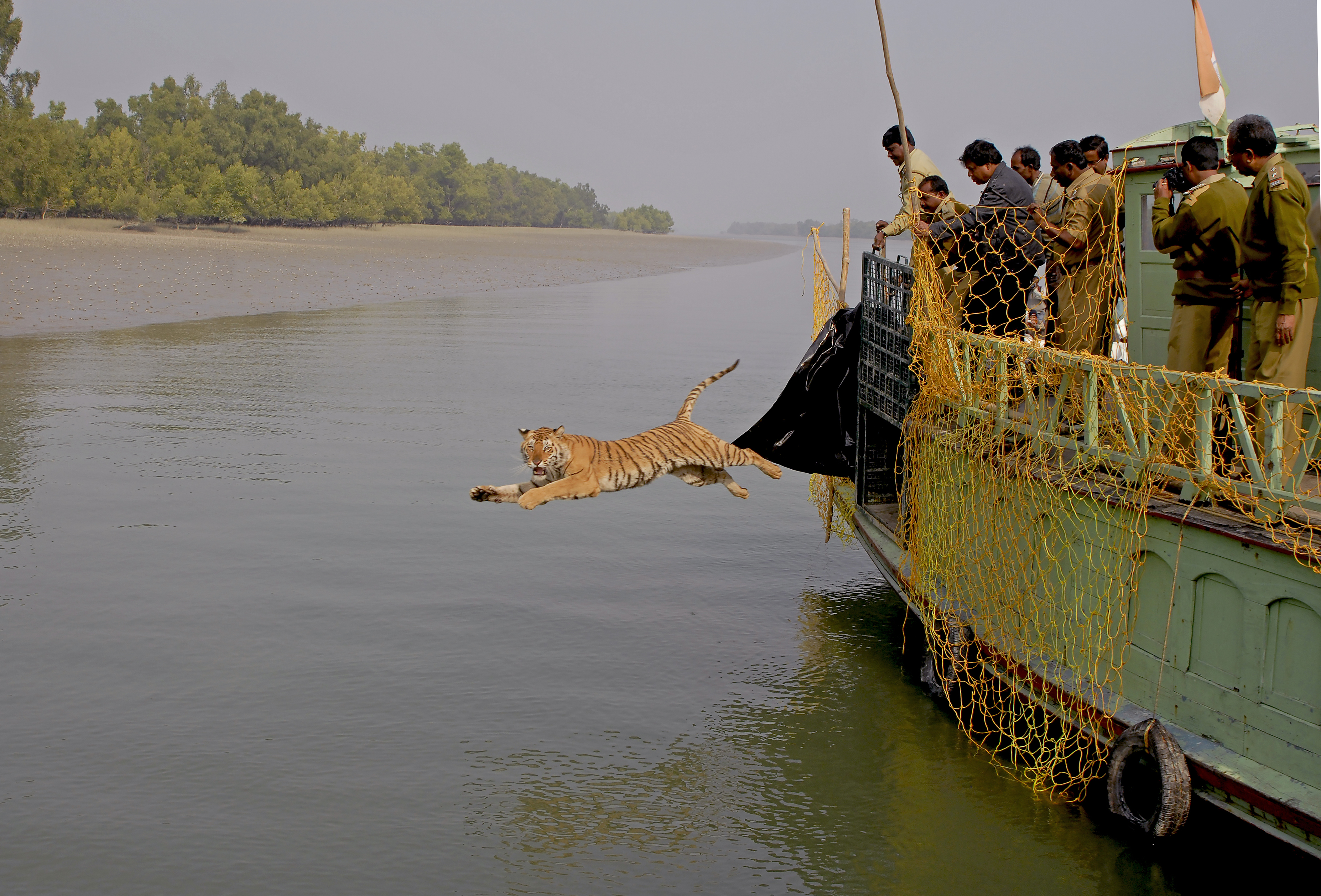 An adult male tiger Panthera tigris leapt to freedom in January 2010 at the Sundarban Tiger Reserve, after being successfully captured and translocated by the Forest Department from the vicinity of a village that he had wandered into, possibly in search of livestock. Tigers are usually released from a boat as it is safer for both the tiger and humans undertaking the operation. For Dr. Anish Andheria, this image symbolises the Sundarban, its people and the complex human-tiger co-existence and conflict in this mangrove forest. Photo: Anish Andheria.
An adult male tiger Panthera tigris leapt to freedom in January 2010 at the Sundarban Tiger Reserve, after being successfully captured and translocated by the Forest Department from the vicinity of a village that he had wandered into, possibly in search of livestock. Tigers are usually released from a boat as it is safer for both the tiger and humans undertaking the operation. For Dr. Anish Andheria, this image symbolises the Sundarban, its people and the complex human-tiger co-existence and conflict in this mangrove forest. Photo: Anish Andheria.
KV: I define wildlife photography as images of landscapes and animals, and then there is conservation photography, which highlights environmental challenges of our times. Both have a place as conservation tools. Amazing photos make people love and care for nature and with strong conservation images, you can get people to take action. However, most photographers are happy to go on vacation on a safari and come back with pretty images. I wish more and more people would spend time in and around parks and document environmental issues. Even in a city, taking images that showcase effects of issues such as climate change can help change people’s minds. Every year one big metro gets flooded and people forget after it’s over. But such images can have a lasting impact.
TK: If practised ethically, wildlife photography is a powerful conservation tool that can create awareness and engage people by opening windows into less understood worlds that they might otherwise be far removed from. While imagery cannot substitute research or experience, it certainly plays an unmatched role in drawing the attention of Homo sapiens – a species that responds to and thinks primarily through visuals. This is beautifully described in an article that I would recommend – ‘Photography and The Feelings of Others: From Mirroring Emotions to The Theory of Mind’.
SR: The power of a good story is undeniable. Conservation photography is proof that visual storytelling is not only a powerful medium but an impactful one. It helps tell stories of the past and also unlocks the possibilities of the future. Photographs capture reality, and hold a mirror up to show what could be, if only we do our part – no matter how small. It has the ability to change the fate of an entire species and habitats under threat. Conservation photography often goes beyond aesthetics and aims to tell stories that highlight the challenges faced by wildlife and the impact of human activities. These visual stories engage people emotionally and intellectually, helping them connect with nature, and understand the need and urgency for conservation. However, it’s important to recognise that photography alone is not a complete solution to conservation challenges. It is a critical cog in the larger conservation effort that involves scientific research, policy advocacy, community engagement, and sustainable practices. Collaboration between photographers, conservation organisations, scientists, and local communities is not just a necessity, but should be the foundation on which meaningful conservation outcomes can be achieved.
The effectiveness of wildlife and conservation photography as conservation tools depends on various factors, including the photographer’s intent, how the audience reacts to those visual stories, and the actions that result from the images.
DM: It’s not cliched, because photography is a tool. When we communicate about conservation issues for some situations, words are not enough to create a connection with the issue. Visuals make it easy by building an emotional connection and giving information. If I talk about elephants dying on railway tracks, only hearing about it does not make the same impact as seeing a photo, which enhances the power of communication. I conduct many sessions with policy makers. I recently gave a talk in Visakhapatnam with coast guards, the Navy, policy makers, IAS officers, and other stakeholders, but if I only spoke, the effect would have been 15-20 times less than with images, which engaged them and created deeper emotional connections. I saw them moved by the visuals. They approached me after the talk and asked me how they could help. Images are not only about connecting people but they are evidence. If I tell a story, it might as well be fiction until I show a photograph, which makes it a fact.
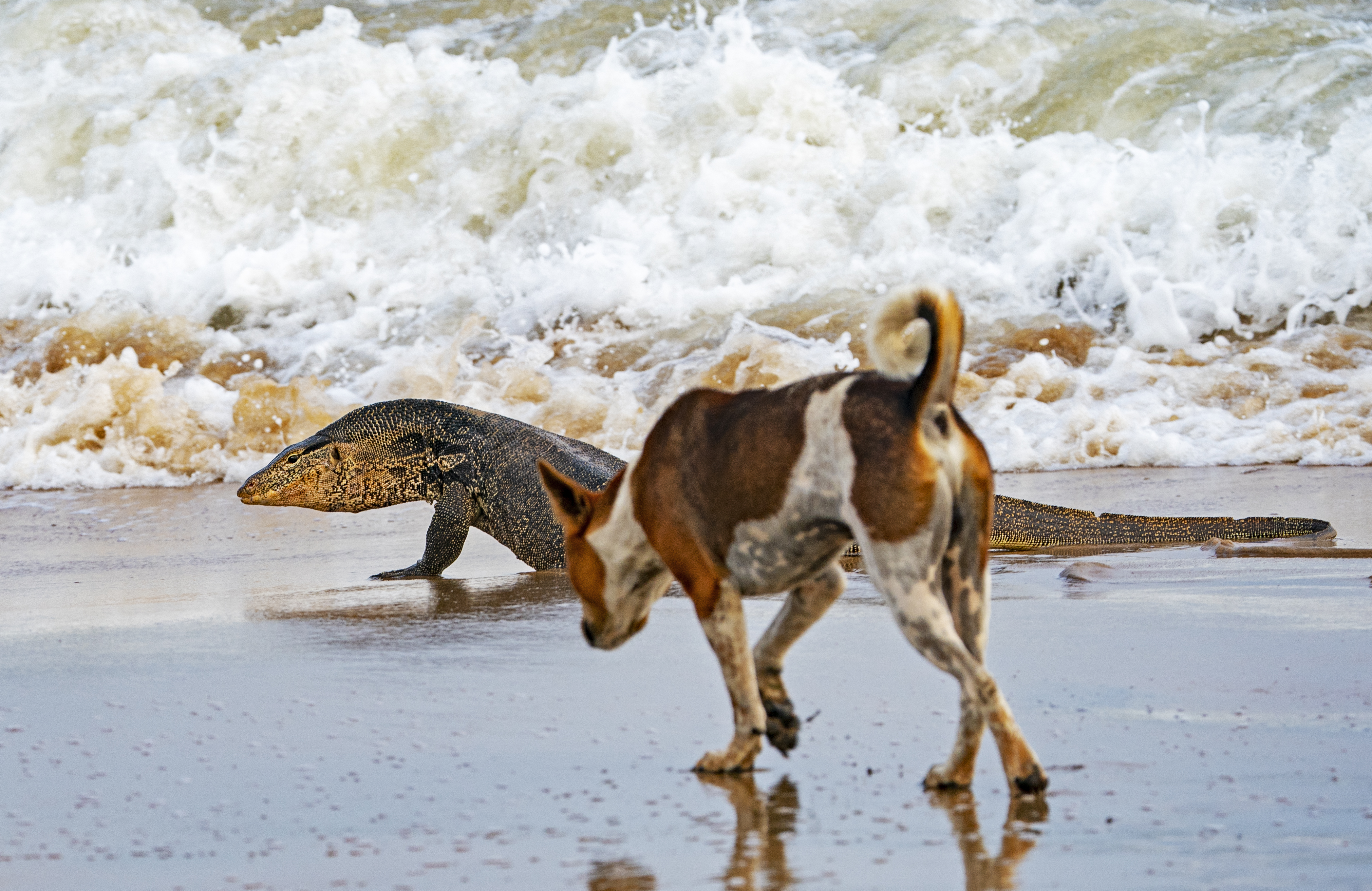
Free-ranging dogs are a major threat to wildlife such as the monitor lizard in India. This image, for Dhritiman Mukherjee, highlights how even remote areas such as the Habalikhati coastal region in the Bhitarkanika National Park, are not safe from feral dogs, often hunting in packs. This is a pressing conservation and welfare issue that requires serious attention. Photo: Dhritiman Mukherjee.
NK: Conservation photography used in the right way is definitely a conservation tool. Even a single image can motivate and transform the human mind. And I’ve seen people changing their opinion after seeing a particular image. In my personal experience, for Aarey’s leopards… photography played a vital role in the kind of following and support we received. I’ve received positive feedback and outcome from this.
SW: I do believe that conservation photography is the answer, because the single image lives on. You can’t find the big blue chip wildlife shows adding anything but a small bit of conservation to satisfy critics later on. So photography, that single image, can live on in storytelling.
Does social media deliver enough reach and strength for photographers to turn their involvement into a passion livelihood?
AA: Social media has definitely played a catalytic role in encouraging hundreds of thousands of people to travel to wildernesses that were not known to them earlier. A lot of people are taking to nature and wildlife photography as a result of the exposure and access they get to professional photographers, travellers, hobbyists and conservationists via social media platforms. In other words, the communication barrier between professionals, amateurs and novices has disappeared owing to social media, opening up an unthinkable number of avenues for amateurs and beginners. This has positively impacted people’s ability to earn money through photography and allied businesses. Extraordinarily, social media has killed the monopolistic environment where only a handful of well-connected photographers hogged the majority of business in this field.
KV: Unfortunately it is hard to make a living solely as a wildlife photographer. Most people either conduct workshops or tours, or people who have a lot of followers on social media get paid engagements. But at the end of the day, there are less than half a dozen of these photographers who are able to fuel their livelihoods through social media.
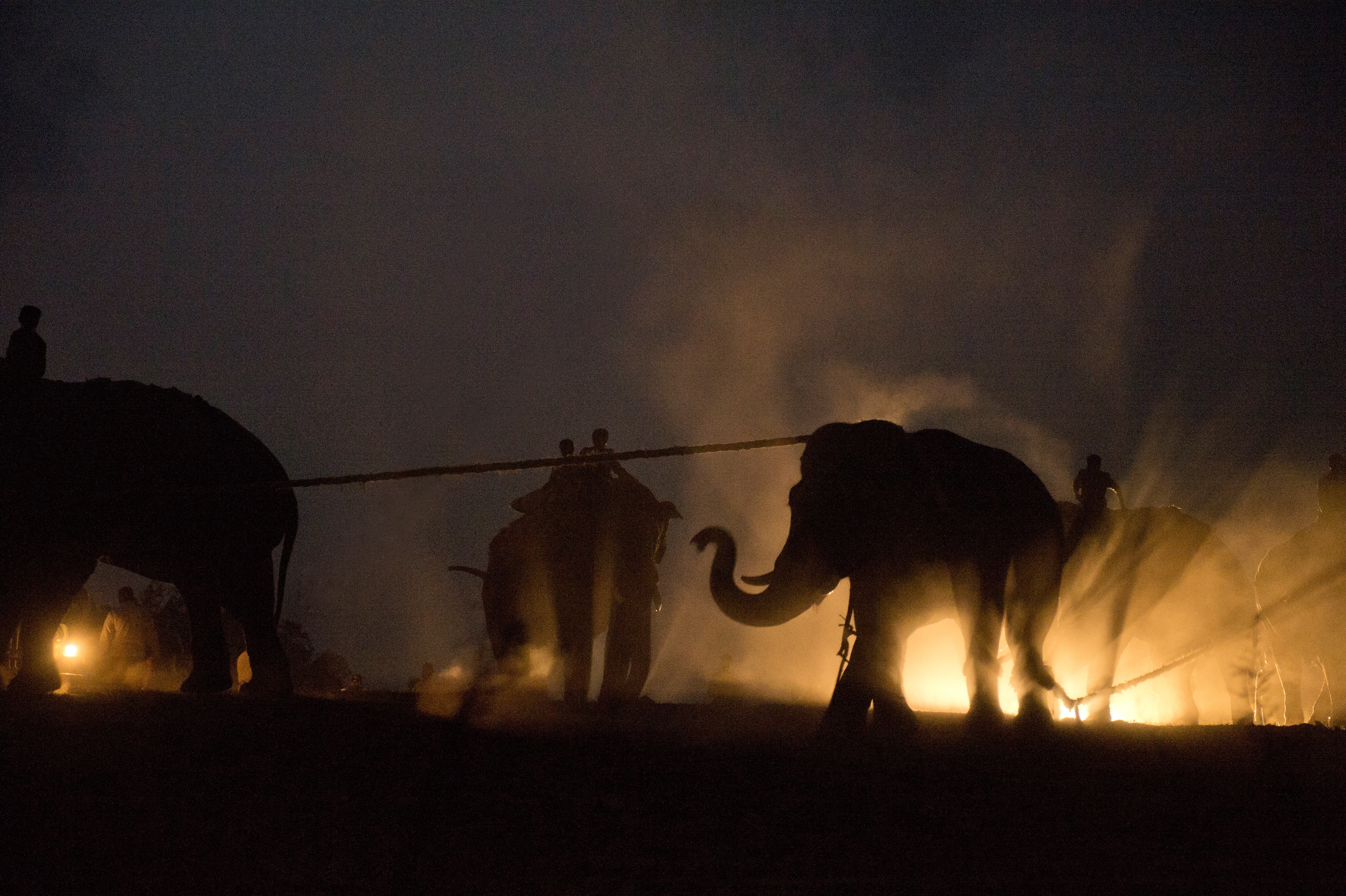
A wild elephant Elephas maximus being captured in Karnataka. Human-elephant conflict is a major issue around Protected Areas throughout the country. As translocating problem animals to other areas has failed to reduce human-elephant conflict, such individuals are increasingly being taken into captivity. Addressing the root causes of the conflict – habitat loss, degradation and fragmentation – is the need of the hour. Conservation photography can be an effective tool to highlight the environmental challenges of our times. Photo: Kalyan Varma.
TK: We need to separate social media and the passion livelihood aspect of this question. For photography to make a tangible impact, both the images and the communication platforms used need to be well thought through, and as wildlife or conservation photographers, we must question and course-correct continuously by asking “What do I stand for?”.
The work can at times leave you ecstatic, and at other moments absolutely devastated. Conservation and wildlife photography is a difficult field to earn a living in. Even the most successful conservation photographers have multiple sources of income, whether photography-related or not. One’s interests and engagement with the topic has multiple potential entry points and it is up to us to take a passion beyond an image, so to speak.
As for social media, which most of us acknowledge is a double-edged sword, I return to my inquiry – what am I sharing my images for? Perhaps the goal is to share a window into an experience, a glimpse into a larger body of work, a critical story that must be told, a summary of a larger story told elsewhere in longform or art in nature that you have witnessed. Each is valid and justifiable – the reach and impact we have depends on what motivates a photographer to make an image and how they choose to share it.
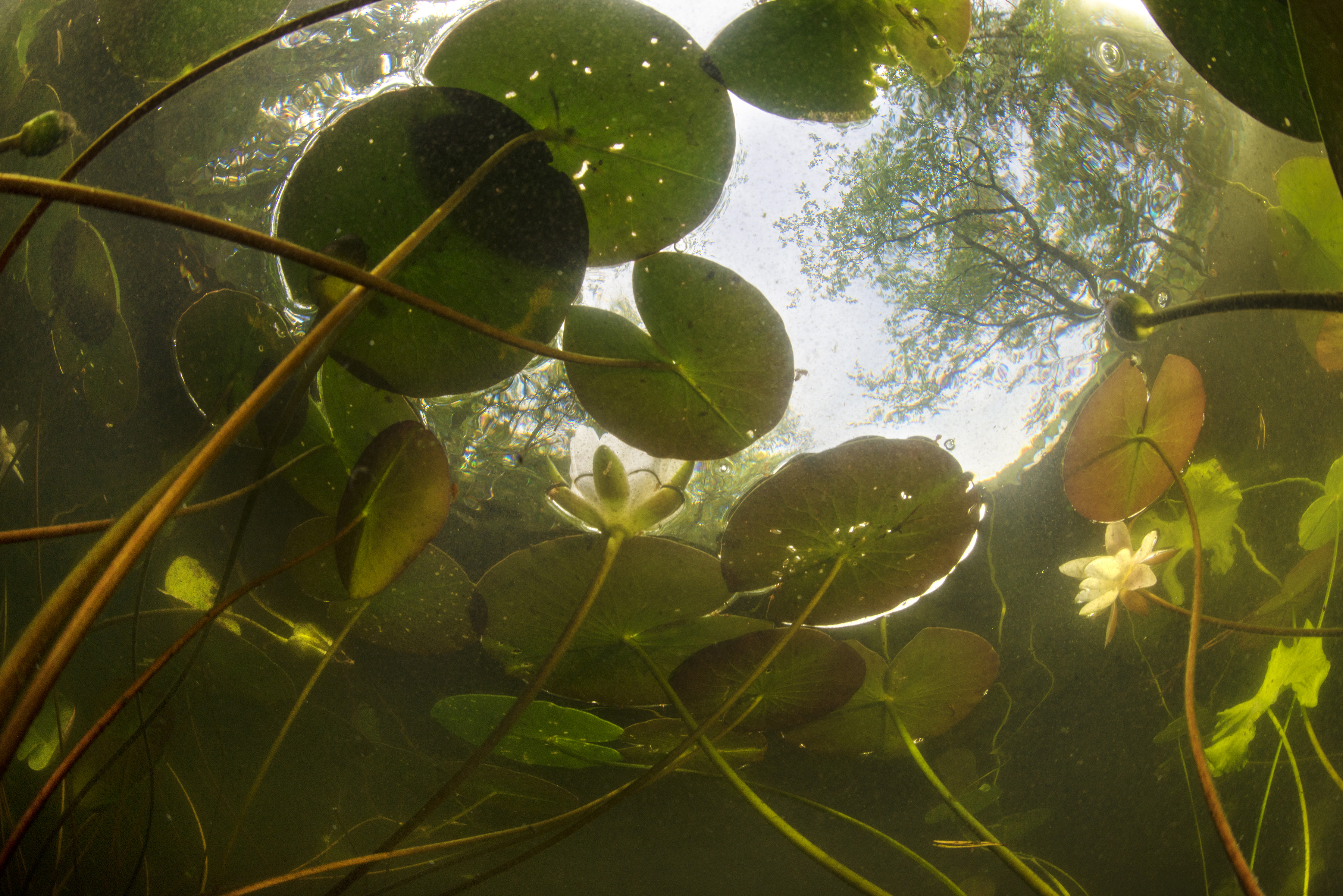
This image titled ‘Beyond the Swamp’ was part of a larger body of images on ‘Swamp Storytelling’ that captured temperate freshwater ecologies and the public perceptions of swamp lands. If practised ethically, wildlife photography is a powerful conservation tool that opens windows into less-understood, remote worlds. Photo: Tasneem Khan.
SR: What you do for a living, is a choice. A passion for what you do, is a better choice than being passionless at work. Social media is a great tool to communicate and tell stories. However, in order to consistently stay on top, there is a need to continually create and provide content, which might take away an individual’s focus from their passion. Are these completely separate? Not necessarily. Nor are these completely intertwined. But the point is to have an equilibrium that works for each individual photographer.
Having a platform to express your passion is really good but making it a livelihood means that you start adding other dimensions to it like consistency, time commitment, detailing, and putting a part of yourself out there, for the world to see, even when it’s not your natural instinct to continuously make your presence known through posts or stories – this has unfortunately become table stakes in order to make social algorithms work in your favour. When that happens, there’s a possibility of compromise, which is why it is not for me. That doesn’t mean it’s not for someone else. I think each person needs to make that conscious choice and understand their equilibrium threshold on their own.
DM: I don’t see issues with a focused perspective. There are bad and good things about social media. Social media is a means to reach out to the masses, and in itself social media is a neutral medium. Books and newspapers had a limited reach, but social media has a much wider audience numbering in thousands and even millions. We should use social media for the benefit of conservation, connect with people who are pro-conservation, and create an online lobby in favour of the natural world. We cannot see the immediate impact of destroying a forest, the effect is felt 10-20 years later, hence people are of the opinion that conservation is a myth. In this scenario, we should build a community of supporters.
As for livelihood, I see this as a volatile medium since it is ever evolving into something else, hence if someone is able to earn, it is their own skill.
NK: Definitely yes. Before YouTube or Instagram, or any social media sites, the platform was limited, and the revenue was also limited, but now, if you know how to market yourself, you can exploit that particular platform. I know many people who are making an income with only YouTube videos. Twenty years ago people used to do a job and wildlife photography used to be a hobby, but now, people are spending more time in the field, and they are able to see more things, capture more things. Social media provides reach and strength to photographers and if they want they can make it a platform for themselves.
SW: Some people are making a good living off social media, but it’s very few, as certain avenues of journalism that were involved in natural history, which would include conservation photography, are very rapidly disappearing.
Do you feel that organisations such as Sanctuary should continue to encourage an ethics code for wildlife and nature photographers who sometimes go to great – and harmful – lengths for an image?
AA: The code of ethics varies from person to person. It is a byproduct of several factors – grooming, subject knowledge or lack of it, respect for all life, a balanced outlook towards success and failure, urge to make unique pictures, urge to compete, fear of losing, and many more. A forum where people can exchange views about ethics without being judged is the need of the hour. An open, peer-to-peer exchange is essential for sowing the seeds of ethical behaviour in people. Rather than changing the mindset of an individual, it is important to create an environment where ethical behaviour is incentivised. Automatically, a majority of new entrants will imbibe the right value system, where the welfare of the ecosystem and its inhabitants will come before a photograph.
KV: The Sanctuary Wildlife Photography Awards has always been at the forefront when it comes to ethics. Many others have followed this and do not allow certain images like baited images, nesting birds and so on. But wildlife ethics should be an ongoing discussion and not simple do’s and don’ts. Fifty years ago it was totally acceptable to go out and shoot a tiger with a gun. Twenty years ago it was acceptable to use a goat as bait to get a photo of a tiger. Today we cannot imagine these things. What we take for granted today can be avoided in the future too, such as playbacks to attract birds, how we handle tourism in tiger reserves, and more.
TK: Any publishing platform must be clear about their ethical code, that would essentially stem from their purpose – why are they showcasing these stories and images? As a long-standing organisation with a large body of work and involvement in conservation and wildlife storytelling, there is no doubt that Sanctuary should continue to hold photographers accountable and expect a high standard with regard to an ethics code for nature photography. Manipulated images, if declared so at the very outset, can be viewed as an artistic representation. However, interfering with animal behaviour, ecological processes and sensory pathways of lifeforms that we are yet to fully understand is extremely problematic. Every nature photographer has at some point, intentionally or unintentionally disturbed or caused interference to some degree – it is critical that we learn from this and take the time to understand the nuances of our subjects and location in order to avoid any negative impact. Publications and production houses that promote or sponsor these images need to adopt a top-down approach that is conscious of the time limitations and output pressure that contribute to photographers cutting these ethical corners.
SR: Governments, business owners, and now photographers – all operate in very grey areas. As something starts to flourish, it becomes essential to establish certain guardrails. As photography – particularly wildlife conservation photography – gains more prominence, recognition, and becomes a mainstream profession for many, it is imperative to have guidelines. Having an ethics code for photographers can serve as a foundational stone for setting those guardrails. This could be done by placing boundary conditions in terms of what is acceptable in order to get that image, and be the visual storyteller that they choose to be without compromising wildlife safety and the habitats they are passionate about.
DM: This has to be done very smartly, as a guideline and not as an authority. It should not be a finger pointing exercise, but something inclusive. Prepare a non-blaming narrative, where information is shared with stakeholders. It is important to present facts and encourage people to make their own moral decisions.
NK: Definitely yes, because as more people are venturing into wildlife photography without any such ethics code or guidance and purely motivated by Facebook or Instagram posting, people might opt for shortcuts for quick results.
Secondly, passing off AI-generated images comes under a separate category of photography ethics. More serious are ethics where wildlife is concerned, like baiting. According to the Wildlife Protection Act or rules of a sanctuary or national park, there are certain do’s and don’ts. If these rules are violated, it is definitely a punishable offence. People should be aware of and abide by rules and ethics.
Once you get an image, there is a separate set of ethics for post-processing. There are many competitions that ask for RAW files for verification. Both sets of ethics, post-processing and capturing, are essential, without which there can be violation or malpractice.
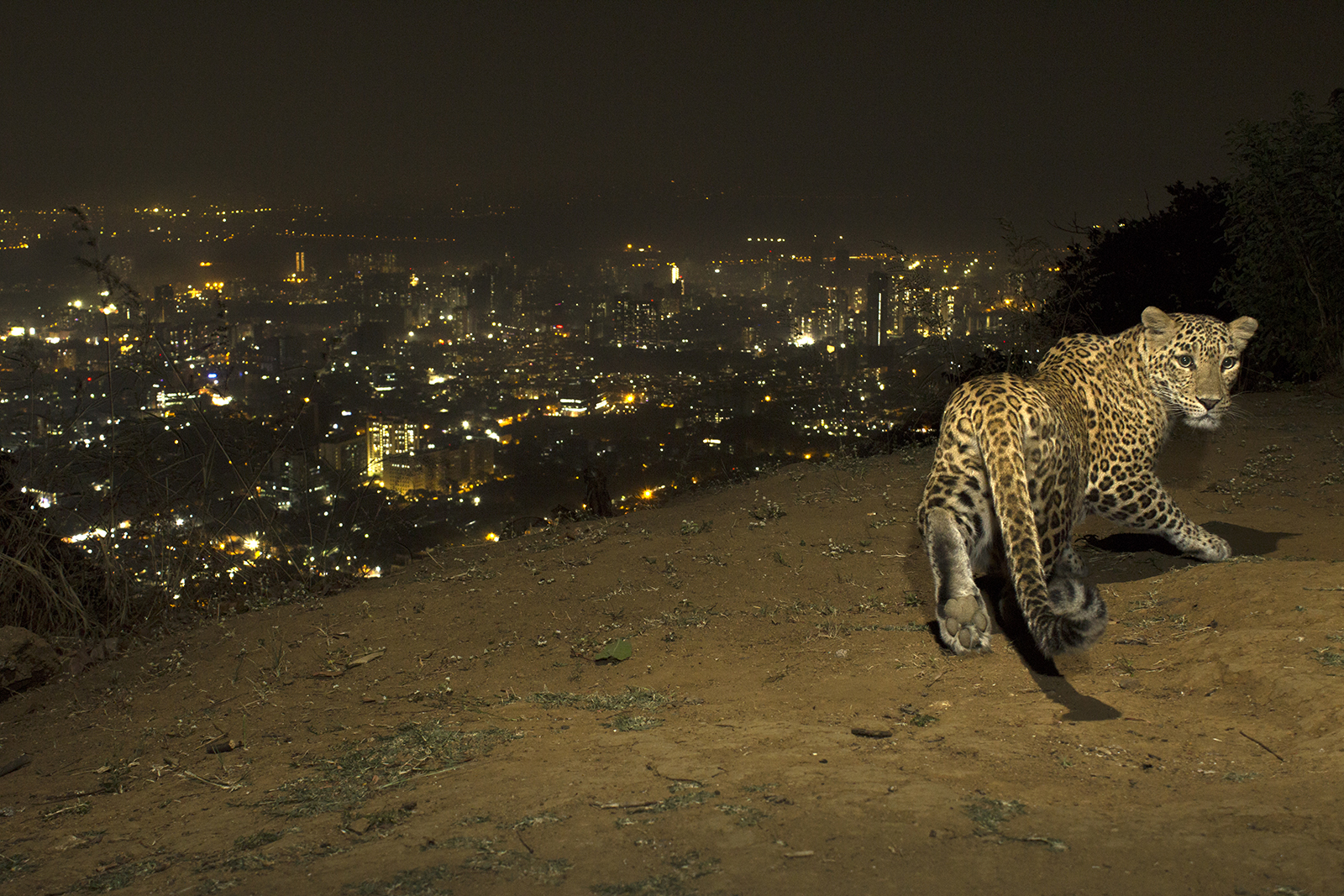
Few people would associate the bustling metropolis of Mumbai with forest and diverse wildlife, let alone the presence of a large cat in the by-lanes of the city. Yet, the Sanjay Gandhi National Park (SGNP) is home to more than 42 wild leopards Panthera pardus fusca. With limited wild prey in the park, free-ranging domestic dogs make up a majority of the diet of these adaptive cats. This is among the only places in the world with big cats co-existing with humans in the middle of an urban landscape, and both at incredibly high densities. The park, a green lung of this megacity, is threatened by ill-planned development. Such images bring the wild to people’s doorsteps, and are the first step in creating awareness and encouraging action by citizens. Photo: Nayan Khanolkar.
SW: I think Sanctuary and other organisations have to promote an ethics code for wildlife and nature photographers. You want to put AI in something, put it in some arty category, and if it is at the cost of species and damage to destinations, that’s something that has to be controlled by the people that run these organisations and parks. You don’t want people to not see or experience the wonder and healing power of nature, and so it has to be controlled and restricted. AI has to be in an art category, and we have to somehow keep photojournalism and journalism sacred. People most likely don’t even know what those rules are. So this maybe needs to have a whole dedicated issue of the magazine. Be the leaders, step out in the front, show the world what’s true and what needs to be told.
How is technology transforming wildlife photography? Is it making it the bastion of the few who can afford the best equipment?
AA: Technology pretty much influences everything we do. Photography is no exception. Several disruptions have come about in this field in the past two decades and going forward, the frequency of disruptive tech will only increase. Some of the most advanced gadgets are exorbitantly expensive and out of reach of most, I believe photography is far more accessible now than it was before the major tech-shift from analogue to digital. Today a Rs. 15,000 mobile phone comes equipped with a decent wide-angle camera that can shoot videos, stills, portraits, landscapes and close-ups. There are many more photographers today than in the 1990s, and technology – computers, mobile phones, AI and machine learning, digital camera tech, mirrorless tech, social media, drones, etc. – has had a big role to play in this transformation.
KV: Tech has come a long way in transforming wildlife photography. The most recent cameras can shoot in very low light conditions (thereby not disturbing an animal with the flash), have become very light, and new gadgets such as drones and camera traps are opening up a whole new world on how we see wildlife. Most of all, I am a big fan of new generation mobile phones. Almost everyone has a decent quality camera in their pocket all the time and because of this people in rural areas are able to document and tell their stories of conservation.
TK: Technology has thrown open the world of photography in both directions – into the realm of highly specialised and expensive equipment as well as very affordable, yet phenomenally impressive digital imaging tools such as our phones, hand-held endoscopes and so on). Technology has undoubtedly transformed the image-making world and now more than ever before we have a vast array of image-capturing devices, artistic software, lenses, lights and processors that allow us to push our creativity in ways that were unimaginable before. As is the case with all tools, the ability to expand our output lies in the vision, motivation and improvisation of the maker. Of course, this accessibility also enables the creation of very realistic fakes. The tools that will be developed to counter this, also lie in technological development.
SR: Most conversations boil down to man vs. machine, which is not necessarily the case. In technology itself, there’s this logic of copiloting, which Microsoft came up with. I think technology will be a copilot for photographers and their creativity. While you can take a great photograph, the advancements will help it happen more remotely, seamlessly, without impacting the wildlife and habitat. Likewise, if we consider the aspect of visual storytelling, how to write better stories that go with the photographs, by leveraging AI tools such as ChatGPT will help optimise for time and effort. In the same way, we have Generative AI tools for visuals, Adobe tools to augment, enhance, and more, and cameras on phones are getting more powerful. What it is doing is where we have citizen developers, we have citizen photographers. So the whole construct of visual storytelling will go to a whole new level with technology.
Yes, equipment and access to tools are expensive and create a divide. At the same time, free AI tools and access to equipment by the hour makes it accessible for those who have constraints with affordability. The most crucial aspect to keep in mind is that the quality of equipment does not solely determine the outcome or success in any field. Talent, dedication and creativity play a significant role.
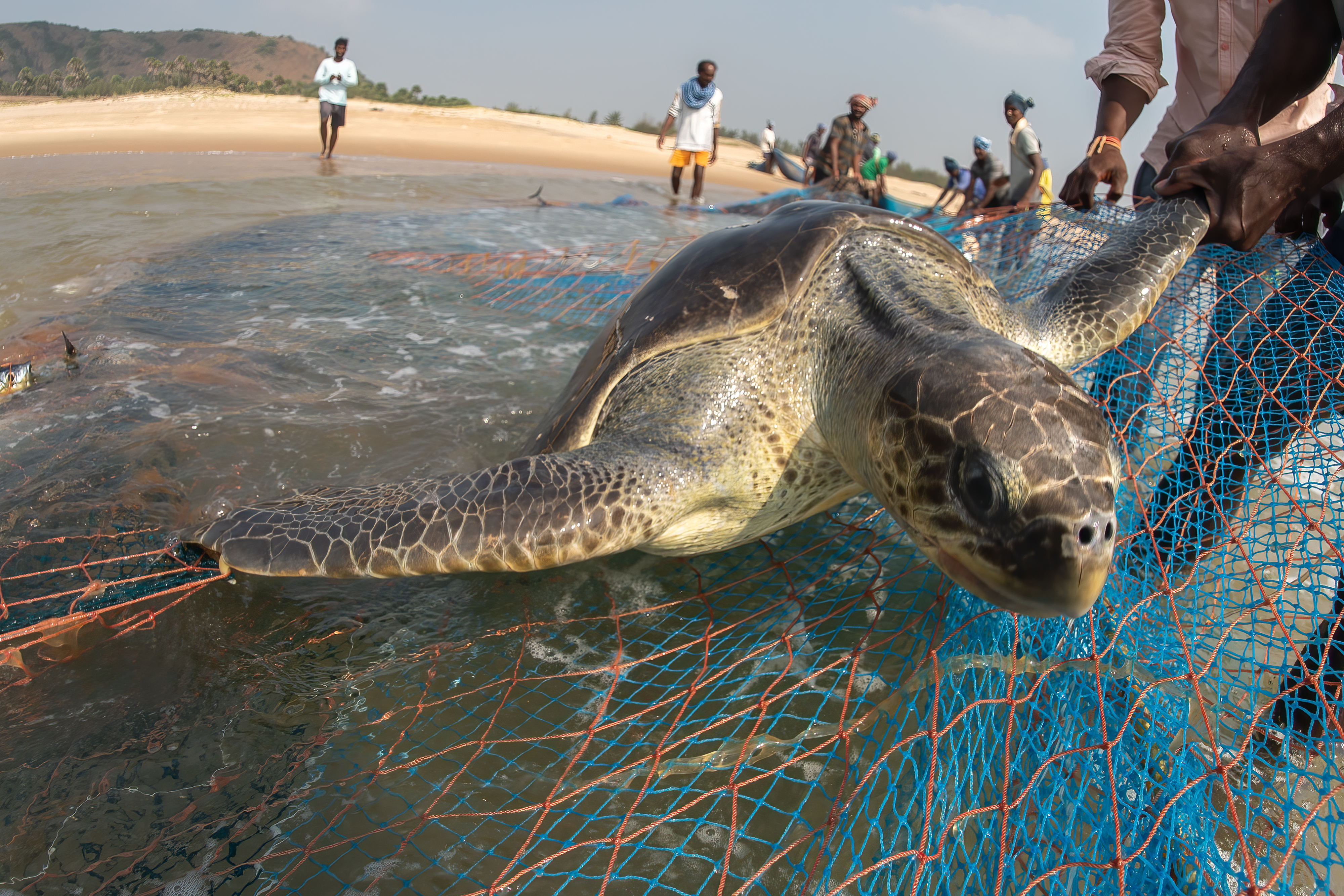
Olive ridley turtles Lepidochelys olivacea often end up as bycatch in fishing nets in the poverty-stricken coastal areas of Andhra Pradesh. But this fortunate turtle was gently untangled by the fisherman from the clutches of the net, to return to the sea. For the photographer, this image represented ‘a sea of hope’ for coexistence. She says, “Despite the many challenges the sea turtle faces to simply survive, I believe that the kindness of people, the work of passionate conservationists and governments will ensure the evolution of the turtle stays on course.” Photo: Sushmitha Reddy.
DM: With the evolution of technology cheaper devices are available to make good images. However, for certain photography techniques, you do need specialised equipment. But if you are passionate about your craft, this is a long journey of patience. I would say this is also a journey of your own willpower. You can achieve success as has been my own case, where I’ve come from a background of very little means. It’s a difficult journey but it is not impossible for those who are truly passionate about this craft.
NK: Technology has definitely changed the face of wildlife photography, enabling you to capture moments which were impossible or very difficult to achieve earlier. What we thought of as challenges 25 years ago have ceased to be so now. The wildlife photography benchmark has been raised much higher. The job has become much easier, but what hasn’t changed or will never change is your desire to highlight a story, and that sense of pointing the camera in the right direction.
There are certain things beyond the scope of the camera, such as human creativity; the camera is only an objective tool, it is your subjective preference, which will always matter. If you use light to your advantage and infuse your creativity, there will always be scope for individuality – you can always create a signature or your own style irrespective of advances in technology.
I don’t think equipment is a restricting factor, because we just think about high-end cameras when we think about this issue, but there is a wide second-hand market where second and even third-hand cameras are available at a cheaper rate. In fact, what I feel is that 25 years ago, it was difficult to do photography since things were not easily available. If you are bothered that every month a new camera is launched or a new lens is announced, which are exorbitantly priced, it is true that photography will be out of reach. After the digital revolution, the photography industry has been growing phenomenally. If you are a dedicated photographer, you will work hard or strive to go to the next level. So I don’t believe this is restricted to a few people, there is always a way around.
SW: A lot of the awards that I’ve won have been with cameras that were the cheapest out there. So it’s all about your unique vision. Many of them do have better equipment than I’ve got, but I won Wildlife Photographer of the Year with the cheapest DSLR that Canon sold, and I won several other awards with inexpensive equipment. So it’s not the equipment, it’s that unique vision and the storytelling desire that you have within you.
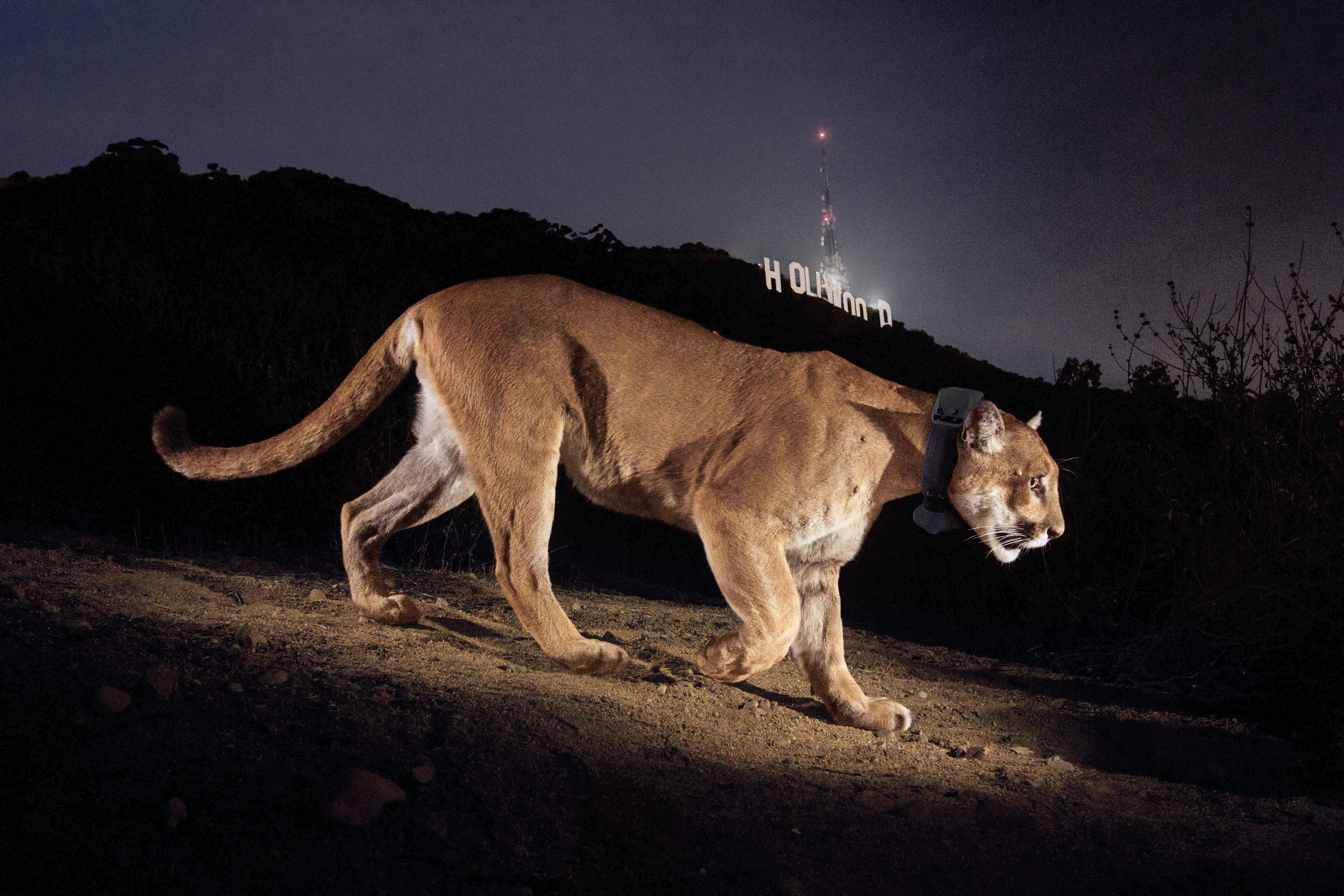
“There’s no cat like him,” says Nat Geo photographer Steve Winter. “He was a celebrity in the land of celebrities.” His image of P-22 under the Hollywood sign took 15 months to capture using a camera trap. The image made the cougar famous – and made Angelenos realise the plight of urban wildlife living off scraps of disconnected habitat. This now-iconic image played a key part in creation of the $87 million Wallis Annenberg Wildlife Crossing, the largest project in the world, which broke ground this year. Winter marvels: “P-22 birthed a wildlife movement in L.A. that is only going to grow and grow.” Photo: Steve Winter.
Anish Andheria: A Carl Zeiss Conservation Awardee, he is a large carnivore biologist with field expertise in predator-prey relationships. A wildlife photographer of repute, he has photographed some of the remotest wildlife reserves in India. He has co-authored two books on Indian wildlife and contributed to several other national and international publications.
Kalyan Varma: An Emmy-nominated wildlife filmmaker, photographer and a conservationist, he has, over the last 15 years, worked on over 30 wildlife films for broadcasters around the world such as BBC, National Geographic, Disney and Netflix. He recently produced and directed ‘Wild Karnataka’, which won two national awards and became the first wildlife film to be aired in cinemas. He actively uses the power of storytelling to communicate issues related to our environment.
Tasneem Khan: Founder of Earth CoLab in India and Sea School in Ireland, she is a diver, sailor, photographer and adventurer. She has been designing and teaching immersive, experiential learning adventures for the past 15 years. As a dedicated teacher and learner, she is most often immersed with a group of students in watery spaces. Her formal training is in marine zoology with extensive research and field-work experience in the areas of intertidal and mangrove ecosystems.
Sushmitha Reddy: A passionate visual storyteller who seeks to make a difference in environmental conservation through her imagery, she is an avid traveller, who aims to shine a light on the best human-animal collaborations for a better tomorrow.
Dhritiman Mukherjee: A Carl Zeiss Conservation Awardee, RBS Earth Hero and the Kirloskar Vasundhara Mitra awardee, he has travelled all over the world, photographing wildlife and nature in the most challenging ecosystems. His work has been published in respected websites and publications including BBC Wildlife, National Geographic Traveller, Lonely Planet, Biographic, New York Times and many more. He has co-authored the book Magical Biodiversity of India and was one of the co-founders of nature and wildlife magazine Saevus. Dhritiman was nominated as one of the jury members of the 6th National Award for Photography by the Government of India.
Nayan Khanolkar: A self-taught nature photographer, he has been documenting Indian wildlife for over 15 years. His background as a biology educationist supplements his on-field photography assignments. Following a decade-long career in bird photography, he is now documenting big cats in urban areas. He aims to sensitise people to animal behaviour and promote conservation through his photographs.
Steve Winter: A wildlife photojournalist who specialises in big cats and has been contributing to National Geographic for nearly 30 years, he has been named BBC Wildlife Photographer of the Year and BBC Wildlife Photojournalist of the Year. In 2013, National Geographic Books published his work Tigers Forever: Saving the World’s Most Endangered Cat, with text written by Sharon Guynup.

.png)






